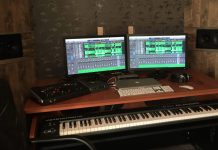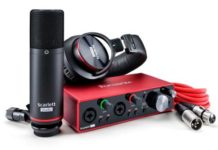If you are musically inclined — and by that, we don’t just mean someone who enjoys listening to music but is also involved in making it — you’d probably be looking to invest in an audio interface to record and mix any instruments or sounds that you want to be working on.
While most computers, smartphones, tablets, and similar gadgets do come with in-built sound cards, all those people who are looking to get into the field professionally look at options like audio interfaces or mixers for a number of reasons.

If you are looking into a primer that will help you with all the basics of audio interfaces and the factors you need to keep in mind while choosing the right interface, you have found yourself at the right place!
What Is an Audio Interface?
You can think of an audio interface as a very efficient middleman that will be able to connect all of your audio gear — including microphones and so on — to the computer that you are working on.
Typically, an audio interface works by converting analog signals to digital audio information, which is the form that the computer will be able to process for results. This sending of digital audio is facilitated through some sort of a connection — which can either be USB, Thunderbolt, FireWire or a specified PCI/PCIe card — which will be discussed in more detail as we move forward.
The conversion isn’t just from analog to digital but also works the other way round — from the digital audio signals put out by your computer to the analog signals that will be audible from the headphones that you are using or the studio monitors that you have fixed.
Under regular circumstances, the audio interface will come with line-level analog inputs and outputs, microphone preamplifiers (at least one), or even some digital inputs and outputs, for example, AES, S/PDIF or ADAT.
Best Audio Interfaces Reviews and Buying Guide
Quick reviews of the best audio interfaces for serious music production. Level up your production by ensuring you have the top-rated audio interface.
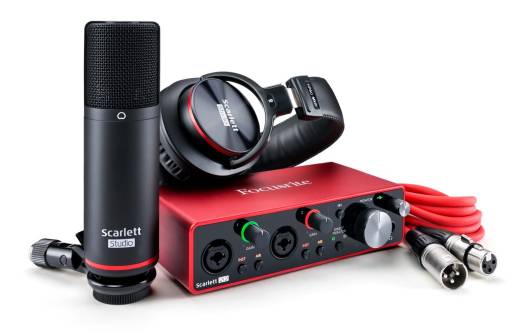
Why Do You Need an Audio Interface?
All digital devices come with a built-in sound card so why do you need to spend the extra money and get your hands on an audio interface?
When you talk in terms of technicalities, the sound card is a type of audio interface in the first place, but the quality of sound is severely limited. In addition to this, the minimalistic input and output offered by sound cards are not ideal for recording the kind of audio that you may be looking at.
Most of these sound cards either just have a consumer-grade stereo line-level input and a headphone output. In some cases, there may also be a consumer-grade stereo line-level output.
There are tons of factors that come into play here — for example, electromagnetic interference, jitter or excessive latency — which end up affecting both the output and the input, causing the sound quality to degrade substantially.
If you want to record and monitor audio that is professional quality, aN audio interface will have to be brought in.
What Features to Look For
There are many different audio interfaces that are available right now, but for a person who is new to the concept altogether — or even someone with some prior knowledge — the vast number of options can seem a little overwhelming.
In such a situation, it can be very helpful if you have a shortlist of features that you should look out for so that you can pick an interface that sits well with your requirements and is able to accomplish all the tasks that you are going to use it for.
Some of the most important features to look out for in an audio interface are mentioned below.
DAW Compatibility
A DAW or digital audio workstation is a digital platform that is designed to record and edit digital sound.
While most DAWs are compatible with most audio interfaces that are commonly chosen, there are some cases where this may not happen. First and foremost, if you don’t really have a DAW that you stick to as of now, this shouldn’t be an area of concern for you.
The main reason for this is that 90% of the major DAWs are going to be compatible with any audio interface that you choose.

For those of you who want to stick to the DAW that you have been using till now, you will have to ensure that you check the compatibility of the audio interface with that particular DAW on the website of the company that is developing it.
While you may expect this information to be available pretty easily, that isn’t always the case. Instead of making this information available under the description of the audio interface, it is mostly kept hidden away in some corner of the website — usually a frequently asked questions page.
One of the reasons why this may be done is that the company doesn’t want to give you any guarantees of what the product’s current DAW compatibility is, especially when this can change over time or with more releases. The likelihood of this happening isn’t too high, but in order to cover all their bases, a lot of people prefer to use the same company’s DAW and audio interface.
Interface Connectors
The audio interface you buy needs to be connected to your computer with the help of specialized interface connectors. As technology is constantly changing and upgrading itself, it is very easy for one form to become obsolete and for another to be considered the “standard” at the moment. The four different types of interface connectors will be discussed briefly in the section below:
Thunderbolt
The new reference standard for interface connectors is Thunderbolt because of many different factors, for example, the extraordinary speed that it offers, combined with the low latency
For example, the latest version of the Thunderbolt — the Thunderbolt 3 — which is found in some of the newest Macs and offers you speeds of about 40 Gbps, which is almost double of what was offered by Thunderbolt 2.
In comparison with USB 3, this version is about eight times faster. In terms of cable lengths, this version can support up to 100 meters with optical cables. This is useful if you are working in a large recording studio.
USB
Another popular interface connector, and possibly the most common one at one point, is the USB and all its versions — 3.0, 2.0 as well as 1.1.
There are many different audio interfaces that you can get your hands on, which will not require a separate supply of power and just work with the power from the USB. This is ideal for situations where you want to record with your laptop. Additionally, some PC Express and PCMCIA card-based interfaces are also an option as they are designed for laptops in particular. Keep in mind that this has the slowest transfer rate.
FireWire
Usually found on some of the more expensive home studio interfaces, FireWire was a big upgrade to the USB port, as the transfer rate was much faster, but these are becoming less and less common these days. This is a little more reliable than the USB port, as the transfer of data is also more consistent. However, you must keep in mind that there are many more platforms that are compatible with USBs.
PCIe
This is an internal card-based interface that has been the standard for professional interfaces for very long. While this cannot be used on laptops, you can use this to install interfaces directly into the computer’s motherboard. This connector gives you great processing power and superfast data transfer, but that also means that this can work out to be a little more expensive.
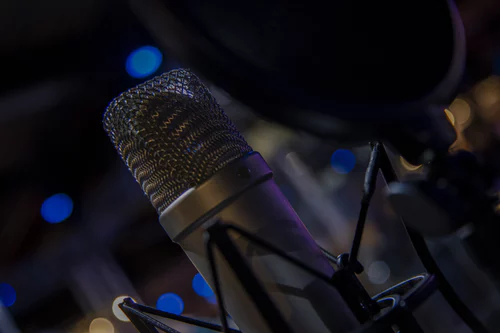
Sound Quality
A lot of people think that they can skip out on a lot of money and still get a great product. While this may be true sometimes, in most cases, you will be getting whatever you pay for, especially in the case of audio interfaces.
The most effective audio interfaces are fitted with the best quality of components, for example, digital converters, microphone preamps, and so much more.
All of these can really raise up the cost of the audio interface.
However, you can keep an eye out for some lower-cost models being produced by the same companies.
The sound quality is dependent on a number of factors, some of the most important of which are going to be discussed below:
- Bit Depth — Acoustic sound is converted into bits or bytes when you record the sound digitally. The one key element that you must remember is that the more the bit depth, the better fidelity you will be getting from the audio signal. This means that if you opt for an interface that has lower bit numbers, the sound produced will not be of very high quality.
- Sample Rate — The second factor that really affects the sound quality is the sample rate or the number of samples of audio carried per second. Most professional studios work with higher sample rates — anywhere between 48kHz and 96kHz — as they may give you better sound fidelity. With CDs, the sample rate stands at about 44.1kHz.
- Converters — These are the elements that actually turn the analog signal into the digital format for your computer, and the other way round. Most people just talk about the first two elements on this list, but the converter quality is also very important in ensuring good quality output.
Input/Output (I/O) Count
The input/output count — often referred to as the I/O count — is one of those features of an audio interface that can make a lot of difference to the process of making audio using an audio interface.
With the more conventional interfaces, the I/O count can stand anywhere between 1 and 2 for a relatively simpler interface and going even above 20 when it comes to the more expensive, professional audio interfaces.
If you are wondering what is the number that you need in particular, you have to look at the number of tracks that you will be recording or monitoring on the audio interface at the same time.
how many inputs/outputs do you need?
Here are some examples that will be able to illustrate this better:
- If you are a solo musician, anywhere between 2 and 4 is a good number for you.
- If you are working with a team — or a small group of songwriters and musicians — anywhere between 4 and 8 should suffice.
- If you are an audio engineer who works with bands, you should be looking at an I/O count that goes above 16.
One thing that you must keep in mind is that different instruments may have different requirements.
For example, an electronic drum kit may require up to 8 inputs on its own, as there are different channels for all the different parts of the drum kit. Such factors need to be kept in mind when you are looking at an audio interface.
Input Channel Types
If you are new to recording and audio interfaces, a lot of things may not work out exactly as you imagined they would. For example, there are many instances where manufacturers of the interface will refer to the different input types while they count the input channels that they are making available for you. To understand these in the best way possible, remember that the following three inputs are usually available in some of the other combinations:
- Mic Input — This allows you to connect a microphone directly to the audio interface that you are using for the recording and monitoring process.
- Line Input — In this case, you will have to add an onboard mic preamp and then use it as a mic channel. This requires an additional step along the way.
- Optical Input — Slightly more complicated than the others, this is a digital input that will require an outboard mic preamp, as well as a digital converter that has an “optical out” in order to be used as a mic channel.
This essentially means that if you are looking for an interface that doesn’t require the addition of a mic preamp, there will not be as many inputs available for you.
When you conduct further research into the type of audio interfaces that you can opt for, you will notice that even the ones that come with a total of 16 input channels have only about 2 to 8 mic inputs available.
This means that you will need some sort of additional equipment to increase the actual number of inputs available with the audio interface.
Form Factor
The last major factor that you need to consider while purchasing an audio interface is the form factor. While this is a term that ends up confusing a lot of people, it just means the actual physical size and the shape of the interface.
There are two major audio interface form factors available for you to choose from, both of which are listed below:
- Desktop Interfaces – These are exactly what they sound like — interfaces that are small enough to be placed on the desk on which you are working, possibly right next to the computer that you are using for recording and monitoring audio.
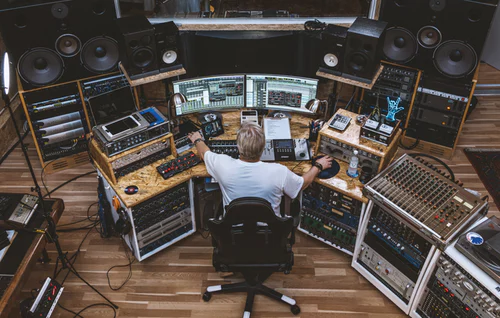
- Rack-mounted Interfaces – The second option is that of rack-mounted interfaces, which are too large to be kept on your work desk. Instead, they have to be mounted on top of a standard-sized rack unit and operated accordingly.
If you are new to audio interfaces, your best bet may be opting for a desktop interface that doesn’t require much work and can be bought for very reasonable prices. These interfaces are very easy to use and do not need to be physically mounted.
However, if you move on to the more advanced studios, you may be better off with a rack-mounted interface because of the flexibility and command you get over the audio.
Best Audio Interfaces Under $200
Check out the 5 best audio interfaces that we’ve found for under $200.
These are fantastic audio interfaces to start producing, mixing and recording with on a budget.
Audio Interface vs Mixers
With the latest technological advancements, recording music has become so easy that almost anyone can buy the right equipment and start making audio. All you need to do is plug that equipment into your computer! However, not every hardware that is available for purchase will have the same effect on your final product, so you need to be careful about what you choose. Here, the discussion is centered around audio interfaces and mixers.
What Is an Audio Mixer?
We have looked at audio interfaces in great detail above, so what is it that makes audio mixers worth it? The simple, one-word answer is to this question is control. These are equipped with equalizers and volume faders, which come with each input channel. This gives you the maximum amount of control over each and every sound that moves to the computer.
There are also some effects — for example, reverb, delay, chorus and so on — which you can then add to each track on your system.
With a reasonably priced mixer — about $150 — you can get your hands on a unit that gives you four pre-amped XLR, line-in inputs as well as many different effects, equalizers, faders and auxiliary inputs and outputs with which you can get your external effect pedals and boards.
As you pay more and more, you can get additional inputs, more effects, better preamps, and filters. They are also very useful when it comes to live performances and are great for times when you want to assemble many different instruments for a better mix.
Advantages of Using Audio Mixers
If you are looking to purchase an audio mixer, there are some definite advantages that you should keep in mind. Keep reading to lead a little more:
- More Control — The audio mixers give you much more individual control over all the inputs offered.
- Can Add Effects — You can add a lot of different effects on the individual tracks with audio mixers.
- Can Be Used for Live Performances — This equipment allows for better mixing when it comes to recording multiple different instruments.
Audio Mixer Disadvantages
Mixers aren’t completely without their set of disadvantages as well. Some of these are listed below:
- Big and Heavy — The size of the mixers is usually much larger than most audio interfaces, which can make them a little unwieldy.
- Not as Easy to Use — If you have worked with audio interfaces in the past, you may find the mixers a little more difficult to handle and use.

Advantages of Using Audio Interfaces
If you are contemplating whether or not you should choose audio interfaces, there are some impressive advantages of choosing these platforms over mixers. Some of these advantages are mentioned below to make it easier for you to make a decision:
- Light and Easy to Carry Around — If you are looking to purchase a product that isn’t limiting in terms of where you can place it or where it can be carried around, the audio interface may work out to be much better for you than audio mixers.
- Impeccable Audio Quality — As these audio interfaces do a fantastic job of converting digital signs to acoustic signals and vice versa, you are able to achieve very good audio quality by employing such interfaces.
Audio Interfaces Disadvantages
There are a couple of disadvantages associated with audio interfaces that you must keep in mind before deciding on such equipment. Some of these are listed below:
- Lesser Control — You will be able to exercise some control over the audio but it will be restricted compared to mixers.
- No Equalizers or Effects — The functionality is very limited when compared to mixers, but most newbies don’t need such advanced features at this stage.
Audio interfaces may not give you some of the features that mixers offer, but you may not need those advanced features when you first get started or even later if your audio production is at a lower scale.
However, whatever stage of production you are at if you are recording and monitoring sounds, it is important that you invest in a good quality audio interface that is compatible with your DAW to get an impressive performance that doesn’t create hurdles for you along the way.
Ensure that you get the right number of inputs you need and get ready to create something fun!


